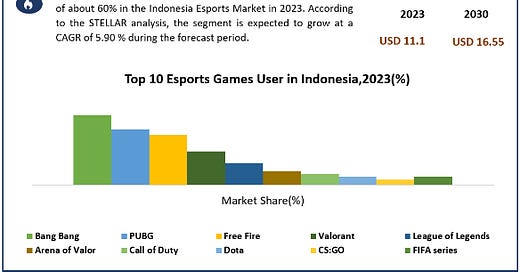Indonesia Esports Market Statistics, Current Trends, Forecast to 2024-2030
Indonesia Esports Market size was valued at USD 11.1 Mn. in 2023 and the total Indonesia Esports revenue is expected to grow at a CAGR of 5.87% from 2024 to 2030, reaching nearly USD 16.55 Mn. in 2030.
Market Estimation & Definition
Definition:
Esports refers to competitive, organized video gaming, often involving live-streamed tournaments, professional players, and an engaged viewing audience. It spans PC, console, and mobile platforms, with revenue generated from sponsorships, media rights, advertising, ticket sales, prize pools, and in-game monetization.
Market Size & Forecast:
2023: USD 11.1 Million
2030 (Forecast): USD 16.55 Million
CAGR (2024–2030): 5.87%
Indonesia is emerging as one of Southeast Asia's fastest-growing esports markets, thanks to high mobile penetration, a young gaming demographic, and increased domestic and international investment.
Download your complimentary sample copy of this report! https://www.stellarmr.com/report/req_sample/Indonesia-Esports-Market/1702
Market Growth Drivers & Opportunities
Key Growth Drivers:
Mobile-First Gaming Culture:
Mobile titles such as Mobile Legends: Bang Bang, Free Fire, and PUBG Mobile dominate the Indonesian esports landscape, accounting for the majority of competitive play and viewership.Rising Engagement & Audience Size:
Around 96% of Indonesians are aware of esports, and more than half regularly follow esports content. Gaming is integrated into daily life, with players often spending 30–60 minutes or more per session.Growing Sponsorship & Media Rights:
As viewership numbers rise, so too does advertiser interest. Brands across telecommunications, fast-moving consumer goods (FMCG), and fintech are increasing sponsorship investments.Government & Institutional Support:
Initiatives from national esports organizations and educational institutions are fostering youth participation and talent development.
Emerging Opportunities:
Locally Developed Games & Tournaments:
While most dominant esports titles are developed overseas, there is an increasing opportunity to create Indonesian-origin titles that can thrive regionally.Female Gamer Growth:
While males still make up the majority of participants, female viewership and gameplay are increasing. Tapping into this audience can drive diversification and inclusive growth.Grassroots Leagues & Education-Based Tournaments:
School and campus-based competitions are nurturing talent pipelines and fostering long-term ecosystem sustainability.
Segmentation Analysis
By Gender:
Male Gamers (2023): 60% market share
Female Gamers: 40%, with growing participation and rising social media presence in streaming and content creation.
By Player Persona:
Hardcore Competitors: Dedicated esports athletes, streamers, and professionals.
Casual Gamers: Recreational players who engage regularly but do not compete professionally.
Mobile-First Viewers & Fans: A substantial audience consuming esports via YouTube, TikTok, and live platforms.
Traditional Sports Fans & Crossovers: Non-gamers who follow esports teams or influencers due to entertainment value.
By Revenue Channel:
Sponsorship & Advertising: The largest revenue stream.
In-game Monetization: Skins, passes, and virtual currencies.
Tournament Prize Pools: Attracting regional and global talent.
Merchandise & Ticketing: Growing with the popularity of live and franchised events.
For additional insights into this study, please refer to: https://www.stellarmr.com/report/Indonesia-Esports-Market/1702
Country-Level Analysis – Indonesia
Esports & Gaming Habits:
Indonesia ranks among the top five mobile gaming countries globally.
Approximately 79% of the population identifies as gamers, creating a vast potential user and viewer base.
Internet & Infrastructure:
With increasing internet access and smartphone affordability, Indonesia's digital infrastructure is enabling esports to scale across rural and urban areas.
Government Role:
The Indonesian Esports Federation and various ministries are collaborating with game developers, tech firms, and education sectors to create structured leagues and national teams.
Challenges:
Heavy reliance on foreign titles may limit local economic retention.
Digital inequality in rural regions may hinder equal participation.
Limited local development of games and platforms restricts content ownership.
Competitive Ecosystem (Commutator Analysis)
Key Players & Stakeholders:
Top Domestic Esports Teams:
EVOS Esports
RRQ (Rex Regum Qeon)
ONIC Esports
Bigetron Esports
These teams compete regionally and globally, attracting millions of followers and brand sponsorships.
Game Publishers Active in Indonesia:
Moonton (Mobile Legends)
Garena (Free Fire)
Tencent & Krafton (PUBG Mobile)
Riot Games (Valorant & Wild Rift)
Tournament Organizers & Platforms:
Franchised events like MPL Indonesia (Mobile Legends Professional League)
Educational tournaments via Garudaku and national school leagues
Porter’s Five Forces:
Competitive Rivalry – High:
Dozens of teams, platforms, and publishers compete for viewership and brand deals.Supplier Power – Moderate:
Game developers hold power over tournament rights and monetization structures.Buyer Power – Increasing:
Brands and advertisers can influence pricing due to increasing platform choices.Threat of New Entrants – Moderate to High:
Entry barriers are low digitally, but competition for attention is intense.Threat of Substitutes – Moderate:
Traditional entertainment (TV, YouTube influencers) and physical sports still compete for user time, especially among older demographics.
Find the Latest Buzz :
Germany Ai In Fintech Market https://www.stellarmr.com/report/Germany-AI-in-FinTech-Market/1567
Mexico Esports Market https://www.stellarmr.com/report/Mexico-Esports-Market/1585
Press Release Conclusion
The Indonesia esports market is on track to exceed USD 16.5 million by 2030, signaling strong and steady growth in a digital-first, mobile-savvy population. With one of the most enthusiastic gaming communities in Southeast Asia, the nation is already a key battleground for global and regional publishers, advertisers, and esports teams.
To capitalize on this momentum, stakeholders should:
Invest in infrastructure and grassroots ecosystems,
Support female and youth engagement,
Promote local content development, and
Drive inclusive digital access across regions.
As esports matures from an entertainment niche to a mainstream industry, Indonesia’s position as a leader in mobile gaming and youth engagement ensures it will remain a vital player in the global competitive gaming landscape.
About Stellar Market Research:
Stellar Market Research is a global leader in market research and consulting services, specializing in a wide range of industries, including healthcare, technology, automobiles, electronics, and more. With a team of experts, Stellar Market Research provides data-driven market insights, strategic analysis, and competition evaluation to help businesses make informed decisions and achieve success in their respective industries.
For more information, please contact:
Stellar Market Research:
S.no.8, h.no. 4-8 Pl.7/4, Kothrud,
Pinnac Memories Fl. No. 3, Kothrud, Pune,
Pune, Maharashtra, 411029
+91 20 6630 3320, +91 9607365656



